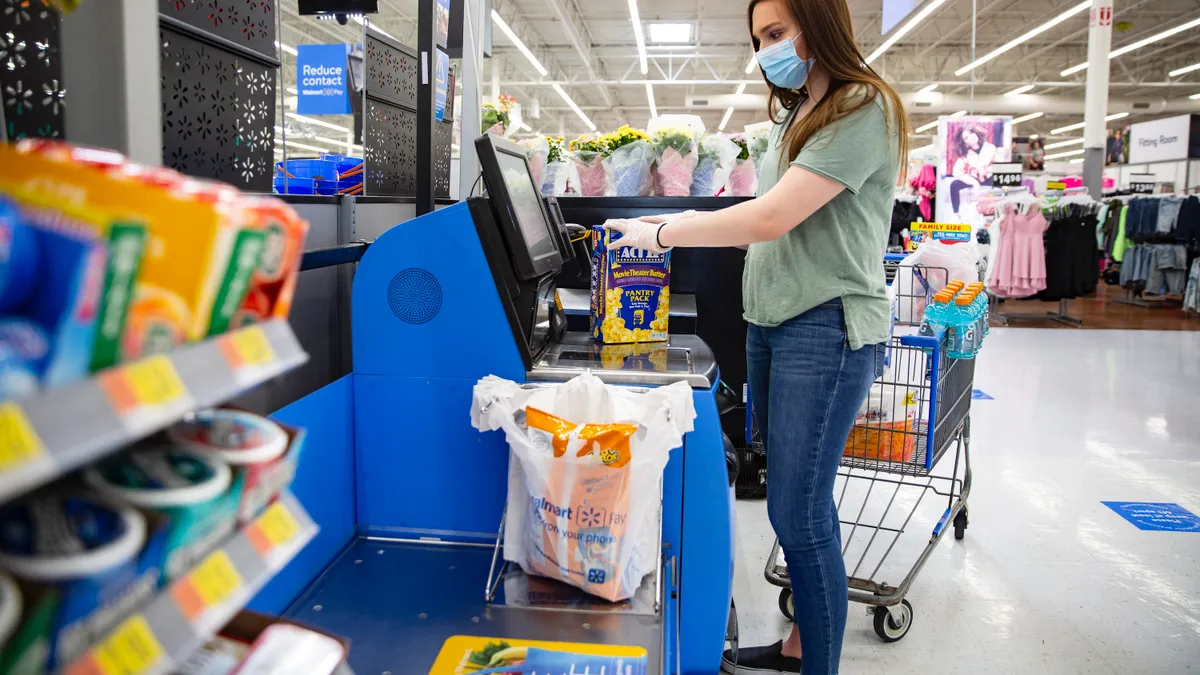Dive Brief:
- COVID-19's unprecedented impact on Walmart's growth last year was tough to beat, but the retailer continues to report robust first quarter growth with e-commerce sales up 37%, market share gains in grocery and U.S. comp sales rising 6%. Sam's Club comp sales also increased 7.2% and e-commerce rose 47%.
- As consumers looked to spend their stimulus checks, total revenue growth of 2.7%, to $138.3 billion, beat expectations. However, revenue was negatively impacted by $4.2 billion due to overseas divestitures, according to a Tuesday press release.
- Given the retailer's figures in Q1, Walmart raised its outlook for the fiscal year. The retailer expects a high single-digit increase in its U.S. operating income and earnings per share.
Dive Insight:
With consumers reverting back to pre-pandemic shopping habits, Walmart looked to sustain growth by increasing its e-commerce sales. Given its online sales increase, this strategy appears to be working well.
"The uplift in e-commerce sales by 37% over the prior year underlines that this strategy is working, although a lot of this growth continues to come from grocery rather than from general merchandise," Neil Saunders, managing director of GlobalData, said in emailed comments. Through it is critical for Walmart to maintain its dominance in the food category, Saunders added that Walmart "must also advance its non-food penetration online, including among younger consumers."
Despite the boost in stimulus checks, Walmart's sales growth has slowed compared to last year's startling figures. In Walmart's first quarter last year, e-commerce sales jumped 74% and comp sales were up 10%.
Comp sales in general merchandise rose more than 20% in Q1 thanks to stimulus spending towards categories like apparel, home, outdoor living and sporting goods, according to Walmart's earnings presentation. Though grocery sales fell compared to last year when consumers stocked up on goods, the retailer still gained market share in the space.
The retailer said more consumers have been shopping in stores, eager to socialize again.
"In the U.S., customers clearly want to get out and shop. We have a strong position as our store environment improves and eCommerce continues to grow," Walmart President and CEO Doug McMillon said in the release. He added that the retailer anticipates "continued pent-up demand throughout 2021."
Though data from Consumer Intelligence Research Partners indicates that Walmart's membership program, Walmart+, had garnered up to 8.2 million members only five months after its launch, executives said during a call with investors and analysts that it isn't their main focus.
"We don't think that Walmart+ should be the primary focus, at the moment, for us with all these other opportunities. So we'll keep growing it at some point," said Brett Biggs, Walmart's executive vice president and chief financial officer. "I know there's a request for that because of streaming services and how much people are talking about subscriptions and memberships these days."
Still, Walmart has continued to heavily invest in other areas of its business. The retailer acquired virtual fitting room startup Zeekit and invested an undisclosed amount to autonomous vehicle startup Cruise to encourage online sales. Walmart is also boosting its presence in the telehealth space through its acquisition of MeMD.















